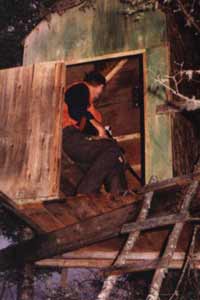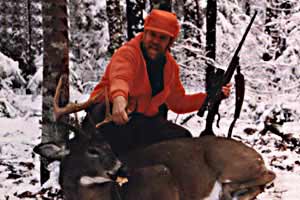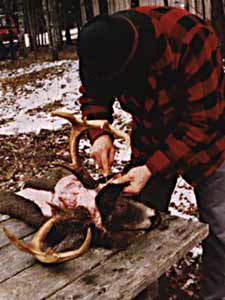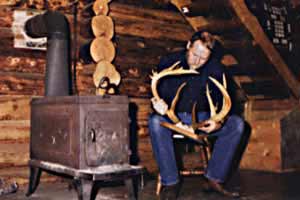Hunting Canada’s swamp buck
by Thomas Tabor
Hunter 10
 On the way from the airport Tom explained, “Hunting just isn’t all that
productive here in New Brunswick. The brush is just too
thick…practically impossible to be quiet. We hunt the bog for the
really big ones, swamp bucks we call ‘em…live around the fringes of the
muskeg bog and they have a pretty dark patch of hair on the brisket.”
On the way from the airport Tom explained, “Hunting just isn’t all that
productive here in New Brunswick. The brush is just too
thick…practically impossible to be quiet. We hunt the bog for the
really big ones, swamp bucks we call ‘em…live around the fringes of the
muskeg bog and they have a pretty dark patch of hair on the brisket.”
I had made the long trek to New Brunswick, Canada in search of an eastern America whitetail deer buck to add to my collection of world deer species. Before my arrival, my host, guide and outfitter, Tom Mosher of Canoose Camp, had attempted to prepare me on what to expect for a trophy quality deer, but it wasn’t until I saw his wall that I lost sleep over the possibilities that awaited me. Over the massive river-rock fireplace hung a dozen or more of the heaviest horned, fallen monarch whitetails that I’d ever seen. Some sported huge drop points that plunged downward 15 to 20 centimetres off the main beams, while others possessed oddly palmated forks nearly as broad as a man’s hand. The spreads ranged from about 50 centimetres across the main beams, to more than 65 centimetres. It was just what I had hoped to encounter - a big eastern Canadian whitetail buck.
Tom hunts primarily from tree stands and ground blinds, due to the dense cover and the cautious nature of the eastern whitetail found here. Each blind, or tree stand, is carefully located in areas of known buck movements - where the big whitetails rub, scrape, live and travel. Tom and his guides expend almost continuous efforts to ensure that each hunter has the best possible location, thereby providing the highest possible chance of success.
It is the hunter’s dilemma. I’d seen it many times before; the weather was perfect the day before the hunt, then Mother Nature stepped in and released her wrath against the world around me. I now sat in my tree stand, 15 feet above the snow-covered terrain. The blind would have been quite comfortable under normal circumstances, but this was far from normal for New Brunswick, at least at this time of the year. The chill of the sub-freezing temperatures was understandable in mid November, but the grisly hurricane-type winds were far from the norm. I could hear the wind bursts heading my way long before the effects could be felt. I listened in uneasy anticipation as the winds made their way down the canyons and ravines, on-route to my hidden location. I had plenty of time to anticipate the consequences, but there was nothing I could do but hold on and maybe say a little prayer under my breath. Each time the wind hit it would cause my blind to sway back and forth some 25 or 30 centimetres. With a loud crack, heal thy, well-established trees of historic proportions began to fall all around me. If you have ever been exposed to a similar situation and heard the eerie sounds that are produced - I’m sure you will take those memories to the grave with you. If you haven’t - there are no words to describe the feelings I was experiencing.
I knew under these conditions there was little chance of spotting a trophy buck. Even with this extreme weather, I was content to be there, thinking about the possibility of taking a buck for my own wall.
Tom’s parting words as he left me early that morning were, “Stay put, stay quiet and about dusk, start back and I’ll meet you on the trail to make sure you get out alright”.
That was a comforting thought, particularly considering the precarious, pre-dawn route we had taken through the muskeg to reach the blind. Muskeg is a unique phenomenon. It is actually vegetation that grows on top of a body of water. Bust through it and you’ll be in the water with heavy vegetation floating over your head. Combined with the chill of the water, I’m sure few people escape the clutches of a New Brunswick muskeg swamp. Earlier, as we had precariously picked our way through the narrow trail I kept thinking about Tom’s warning. “No-one really knows just how much water lies below the floating muskeg…could be 30-feet deep for all we know.”
 As I had feared, nothing moved that day. The whole camp registered zero
for the meat pole. I knew, however, I’d be back out again the following
morning - come hurricane, blizzard, flood, or sunshine. That’s what you
have to do sometimes to better your chances of a successful hunt. I
only had five days to get my trophy and I wanted to take full advantage
of the opportunities afforded to me.
As I had feared, nothing moved that day. The whole camp registered zero
for the meat pole. I knew, however, I’d be back out again the following
morning - come hurricane, blizzard, flood, or sunshine. That’s what you
have to do sometimes to better your chances of a successful hunt. I
only had five days to get my trophy and I wanted to take full advantage
of the opportunities afforded to me.
We overslept a little the next morning. Daylight-to-dark blind sitting takes its toll on a fellow and unfortunately, I didn’t get to my blind until about half an hour after the crack of dawn. Tom stayed back in fear he’d spooked anything already in the area. Cautiously, I climbed the ladder to my lofty perch, carefully inspecting each and every clump of shadows, much as a surgeon would during an exploratory patient examination. But alas, nothing was found, so I settled in for the day, or until my luck would change.
The wind had died down, but still an occasional blast would start the blind rocking from side-to-side. An additional eight centimetres of snow had fallen during the night.
My blind was located on top of a ridge that separated two bog areas. Tom explained that the big swamp bucks often use the ridge for travel. To the left, and in front of the blind, was a scrape that the bucks return to each year. Last season two trophy-quality whitetails were shot from this same tree stand, with only one day separating the kills. “They just keep coming back to the same scrape area”, Tom offered.
I couldn’t see the actual area of the scrape, but I didn’t really want to spread my scent about needlessly, so I took Tom’s word that it was there. The dense brush totally obliterated my view, but a well-worn trail lead in that direction. This was much thicker brush than I’d been used to hunting, causing me to turn my 3x9 variable Leupold scope down to its lowest setting. There would be no way that any shot from this location would ever exceed 70 or 80 metres. If I was lucky enough to get a shot, it was obvious I would be picking and choosing an opening between the trees and brush to slip my bullet through.
Remarkably, even with the close range shooting, there are a lot of missed shots at Canoose Camp. This is largely due to hunters not being used to shooting downward from a tree stand. You simply have to take into account the angle of your shot and be careful not to under shoot your target.
I had two possible entry points to monitor. To the right there was a well-used game trail leading directly to the front of the blind. And, secondly, and the entry point that would prove to be the best one, was a slightly elevated knoll and crossing point - for a buck to reach the scrape.
 While many hunters may become bored while sitting in a blind from
daylight to dark, there are a lot of things to see that you’d normally
miss if you weren’t hidden from view. One of my fellow hunters in camp
was fortunate enough to spot a bobcat in the process of killing a
grouse. Virtually every day someone would report seeing a bushwolf on
the prowl. The bushwolf is New Brunswick’s jumbo variety of the
American coyote, weighing about 60 pounds (27kg). Some believe this
species is actually the offspring of a wolf/coyote mix, but no one
seems to know for sure.
While many hunters may become bored while sitting in a blind from
daylight to dark, there are a lot of things to see that you’d normally
miss if you weren’t hidden from view. One of my fellow hunters in camp
was fortunate enough to spot a bobcat in the process of killing a
grouse. Virtually every day someone would report seeing a bushwolf on
the prowl. The bushwolf is New Brunswick’s jumbo variety of the
American coyote, weighing about 60 pounds (27kg). Some believe this
species is actually the offspring of a wolf/coyote mix, but no one
seems to know for sure.
It would have been easy to allow my eyes to rest and drop off to sleep, but I knew I could not let my guard down, even for a moment. It was mid November and even though the bucks should have been heavy into the rut, the deer seen thus far were unusually cautious, timid and nervous. Their necks were well-swollen, but they certainly didn’t act like the typical rutting whitetail. No one had a valid explanation for this unusual phenomenon, other than possibly the abnormal weather conditions, but knows for sure?
I had to rise to my feet to see the knoll area, but I could more easily watch the lower trail from the bench seat inside the blind. Every minute I would thoroughly look over the entire area. I knew a trophy buck could quickly and easily slip through undetected in the thick cover and I would have to stay alert if I expected to get a shot.
In another hour and 15 minutes, I’d be climbing down to face the trip across the bog. My knees and muscles ached from the lack of movement. I’d grown accustomed to seeing every bush, tree and ground irregularity that surrounded my blind. But this time, as I cautiously rose to my feet and peered outward, something was different! A peculiar colour, an out-of-place brown patch had materialised on the elevated knoll. ‘Funny’, I thought to myself. ‘I don’t remember seeing that spot before’. I strained to make out the details, but none were visible. Then, a slight movement. Ever so slight, but enough to convince me. No question about it, it was a deer, but a doe…buck...trophy…what?
As is always the case in these times of adrenaline rushes, time slowed to a speed only our imaginations can envision. It seemed to be an eternity, but must have only been moments. Ever so slowly I slipped my Ruger single shot rifle from its home in the corner of the blind and snaked the barrel out of the small opening. I recall carefully positioning the padded sling beneath the fore-arm, forming a soft cushion for it to rest on. I wasn’t going to take any chances of a missed shot due to resting the rifle on a hard surface. While maintaining total concentration on my intended quarry, I worried how I would get the safety off without hearing the usual ‘click’. Quarters were close and surely any sound, even the slight sound of a safety being taken off, would send the deer disappearing into the brush in an instant. My mind raced as I attempted to smother any sound with my glove. Ever so slowly I slipped the safety forward. I fully remember how surprised and even a bit proud I was when it slipped into the off posit
ion virtually sound-free. It was off, my rifle barrel awaited its calling and nothing had changed, moved or showed any response whatsoever. Maybe this wasn’t a good sign? Why all the caution? Surely if the deer hadn’t sensed something wrong it would have moved into the open and in the direction of the scrape. Anxiously I waited.
Then, without warning, it began with a single short step forward. Instantly, I could see it was a buck, but only the neck and lower part of the horns were visible. The bases appeared good, but I preferred a better shot and certainly a better view of the animal. I didn’t have long to wait. Half a step more and it became apparent - this was the one I had been waiting for. The body mass was nothing short of huge. I’ve seen a lot of big deer, including some very large mule deer from western US, but I wasn’t prepared to see this kind of bulk in an eastern whitetail. Without question, I was sure when the time came my finger would be tightening around the trigger of my .300 Winchester magnum.
There was no wind. There was no sound, not from me or the deer. However, it was obvious he knew something was awry.
 I’ve always preferred lung/heart shots whenever possible and would
never send a bullet to the neck area unless there was absolutely no
other choice. Nevertheless, on the next step it became all too obvious
that the big buck had forgotten about the scrape and was going to
abandon his earlier intentions completely. Spinning around, he was
silently making his exit. Within moments he would be gone, swallowed up
by the dense brush. The only possible shot was over the top of the tail
and into the base of the neck.
I’ve always preferred lung/heart shots whenever possible and would
never send a bullet to the neck area unless there was absolutely no
other choice. Nevertheless, on the next step it became all too obvious
that the big buck had forgotten about the scrape and was going to
abandon his earlier intentions completely. Spinning around, he was
silently making his exit. Within moments he would be gone, swallowed up
by the dense brush. The only possible shot was over the top of the tail
and into the base of the neck.
Without any further hesitation, the silence was shattered by the bellow of the .300, sending the 180 Nosler partition bullet on its way. Penetrating the back of the neck, along the left side, the big buck crashed to the ground.
Tom heard the shot and walked in just in time to help with the packing-out. Carrying a buck through a muskeg swamp was a major challenge, but one well worth the time and effort. Field dressed, it was estimated the buck would tip the scales at about 200 pounds (90kg). That’s big in my book, but only average to the New Brunswickers. The buck wouldn’t make the book, but it was a fine example of an eastern whitetail deer and worth the long journey to eastern Canada. The old buck had been a real fighter and had several of its points broken to show for it. The horn measured 17.5 inches (44.5cm) and had four very heavy points on each side and an additional two eye guards. This was surely a unique trophy, from a most unique location - in the back-country of rural Canada.
New Brunswick is a world away from the Australian outback. From the muskeg swamp to the blustery winter weather, this hunt provided much more than simply another deer hunt. It was an adventure of major proportions. It allowed the Author to make a new friend, by the name of Tom Mosher and it even resulted in a great whitetail trophy.
Captions
Image 1: Each day the author waited, full of
hope that a whitetail buck would show.
Image 2: The author took this fine
representative whitetail buck with very heavy horns measuring 17.5
inches. The horn had four points on each side plus eye guards.
Image 3: Tom Mosher volunteered to cape out my
buck in anticipation of having it mounted.
Image 4: The author spent a great deal of time
admiring the huge horns that seemed to be everywhere in the lodge.
